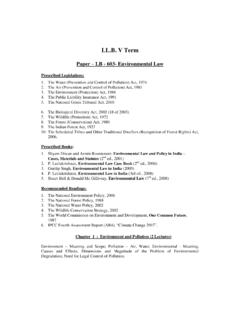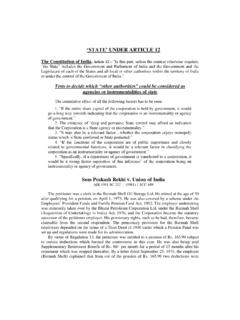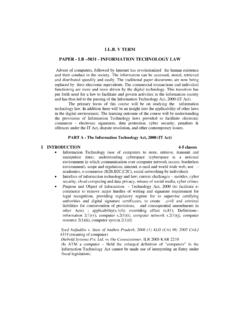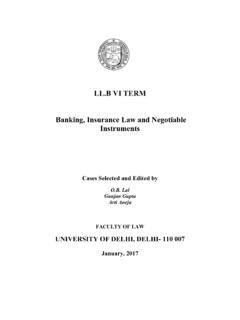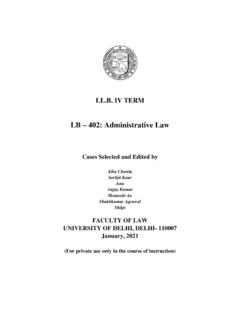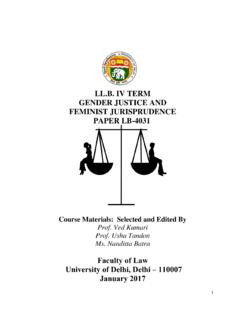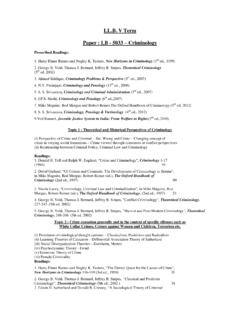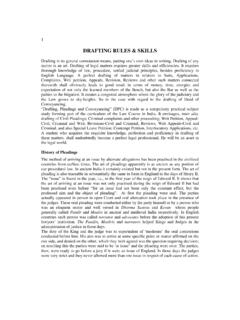Transcription of Need for Alternatives to the Formal Legal System
1 Need for Alternatives to the Formal Legal System [Special Address by Dr. , Part-time Member, Law Commission of India in an International Conference on ADR, Conciliation, Mediation and Case Management Organised By the Law Commission of India at New Delhi on May 3-4, 2003.] The need for Alternatives to the Formal Legal System has engaged the attention of the Legal fraternity, comprising judges, lawyers and law researchers for several decades now. This has for long been seen as integral to the process of judicial reform and as signifying the `access-to justice approach. In their monumental comparative work on civil justice systems, Mario Cappelletti and Bryant Garth point out that the emergence of the right of access to justice as the most basic human right was in recognition of the fact that possession of rights without effective mechanisms for their vindication would be It was not enough that the state proclaimed a Formal right of equal access to justice.
2 The state was required to guarantee, by affirmative action, effective access to justice. Beginning about 1965, in the , the and certain European countries, there were three practical approaches to the notion of access to justice. The first wave in this new movement was Legal aid; the second concerned the reforms aimed at providing Legal representation for diffuse interests, especially in the areas of consumer and environmental protection; and the third, the `access to justice approach, which includes, but goes much beyond, the earlier approaches, thus representing an attempt to attack access barriers in a more articulate and comprehensive manner. 2 The last mentioned approach encourages the exploration of a wide variety of reforms, including changes in the structure of courts or the creation of new courts, the use of lay persons and paraprofessionals both on the bench and in the bar, modifications in the substantive law designed to avoid disputes or to facilitate their resolution, and the use of private and informal dispute resolution mechanisms.
3 This approach, in short, is not afraid of comprehensive, radical innovations, which go beyond the sphere of Legal representation. 3 In India too the need to evolve alternative mechanisms simultaneous with the revival and strengthening of traditional systems of dispute resolution have been reiterated in reports of expert bodies. Reference in this context may be made to the Report of the Committee on Legal Aid constituted by the State of Gujarat in 1971 and chaired by Justice Bhagwati (as he then was) which inter alia recommended 1 M. Cappelletti and B. Garth, Access to Justice - the worldwide movement to make rights effective: a general report in M.
4 Cappelletti and B. Garth (eds.), Access to Justice A World Survey, Volume I, Sijthoff & Noordhoff Alphanaanderijan (1978), 5 at 8-9. This shift occurred, according to the authors, simultaneous with the emergence in the twentieth century of the welfare state . 2 Id. at 21. The authors explain (at 49): We call it the `access-to-justice approach because of its overall scope; its method is not to abandon the techniques of the first two waves of reform, but rather to treat those reforms as but several of a number of possibilities for improving access. 3 Id. at 52 Need for Alternatives to the Formal Legal System 2 adaptation of the ` neighbourhood law network then in vogue in the ; the Report of the Expert Committee on Legal Aid: Processual Justice to the People, Government of India, Ministry of Law, Justice and Company Affairs (1973) (1973 Report) which was authored primarily by its Chairman Justice Iyer (as he then was) which while urging ADR (lok nyayalayas) in identified groups of cases exhorted the preservation and strengthening of gram nyayalayas.
5 And the Report of two-member Committee of Justices Bhagwati and Krishna Iyer appointed to examine the existing Legal aid schemes and suggest a framework of a Legal services programme that would help achieve social objectives [Report on National Juridicare Equal Justice Social Justice, Ministry of Law, Justice and Company Affairs (1977) (1977 Report)]. The last mentioned report formulated a draft legislation institutionalising the delivery of Legal services and identifying ADR, conciliation and mediation as a key activity of the Legal services committees. Each of these reports saw the process of improving access to justice through Legal aid mechanisms and ADR as a part of the systemic reform of the institution of the judiciary coupled with substantive reforms of laws and processes.
6 The present have of Legal reforms have only partly acknowledged and internalised the recommendations in these reports. Still, the implementation of the reforms pose other kinds of challenges. The attempt through the introduction of of the Code of Civil Procedure 1908 (CPC) is perhaps a major step in meeting this challenge. The reasons for the need for a transformation are not much in dispute. The inability of the Formal Legal System to cope with the insurmountable challenge of arrears argues itself. The Parliamentary Standing Committee on Home Affairs found that as of 2001, there were in 21 High Courts in the country, lakh cases Of the 618 posts of High Court judges there were 156 vacancies as on January 1, The position in the subordinate courts was even more alarming.
7 There was a backlog of over 2 crore (20 million) cases for as long as 25 to 30 Of these, there were over crore ( million) criminal cases and around 70 lakhs (7 million) civil The total 4 J. Venkatesan, Panel concern over backlog in courts , The Hindu, New Delhi, March 10, 2002, 12: The Committee was particularly disturbed by the fact that cases were pending for over 50, 40 and 30 years in the High Courts of Madhya Pradesh, Patna, Rajasthan and Calcutta. And more than 5 lakh cases were pending for over 10 years 2 lakhs in Allahabad, 1,46,476 in Calcutta 28,404 in Bombay and 5,050 in Madras. 5 Indian Law Institute, Judicial System and Reforms in Asian Countries: The Case of India, Institute of Developing Economies, Japan External Trade Organisation (IDE-JETRO), (March 2001) 39.
8 6 Ibid. 7 Id. at 35. Need for Alternatives to the Formal Legal System 3 number of subordinate judges8in all the states and union territories in the country, as of September 1999 was 12, Despite this severe strain on resources, the performance of the subordinate judiciary has been remarkable. A joint study by the Indian Law Institute and the Institute of Developing Economies, Japan in March 2001, revealed that in a single year (1998) the number of cases disposed of by the district and subordinate courts was crores ( million).10 At the end of every year, however, the pendency of cases remains at the figure of around 20 million, which means the subordinate judiciary is running hard to remain at the same In its 120th Report in 1988, the Law Commission of India had recommended that the state should immediately increase the ratio from judges per million of Indian population to at least 50 judges per million within the period of next five years.
9 12 In 2001, the ratio remains at 12 or 13 judges per million While it is debateable whether this relating of the number of judges should be to the population as a whole or to the number of cases in the various courts, there is no gainsaying that judicial officers are not paid very well and work in deplorable conditions where basic infrastructure is unsatisfactory or All of the above should in fact persuade prospective and present litigants, as well as those engaging with the Formal Legal System as judges and lawyers, to reservedly embrace the notion of ADR, conciliation and mediation. However, it does appear there are many more factors that ail the Formal Legal System which, if not adequately 8 Id.
10 At 6: This would include district and sessions judges, additional district and sessions judges, subordinate/assistant sessions judges, chief judicial magistrates, metropolitan magistrates and judicial magistrates. 9 First National Judicial Pay Commission Report (1999) 1229. The judge strength rose from 9232 in 1985 to 12771 in September 1995. 10 Indian Law Institute, Judicial System and Reforms in Asian Countries: The Case of India, Institute of Developing Economies, Japan External Trade Organisation (IDE-JETRO), (March 2001) 37. 11 The same study (id. at 36) points out that at the end of 1998, there were crore cases ( million) which were pending in the subordinate courts for less than ten years. 12 120th Report of the Law Commission of India on Manpower Planning in the Judiciary: A Blueprint Ministry of Law, Justice and Company Affairs, Government of India (1987), 3.
